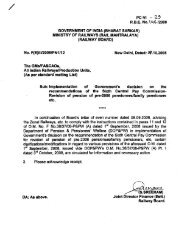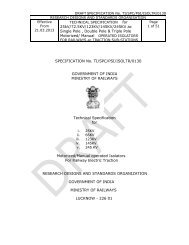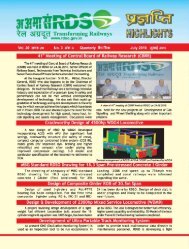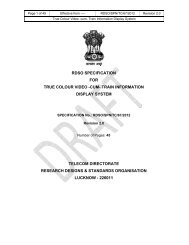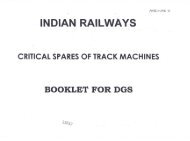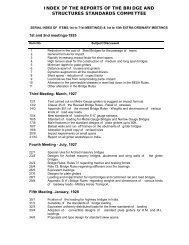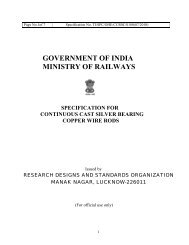Tender invited for Development of Train Collision Avoidance System
Tender invited for Development of Train Collision Avoidance System
Tender invited for Development of Train Collision Avoidance System
Create successful ePaper yourself
Turn your PDF publications into a flip-book with our unique Google optimized e-Paper software.
ISO 9001: 2008 Effective from 18.06.2012 RDSO/SPN/196/2012 Version 3.1.1<br />
Document Title : Specification <strong>of</strong> <strong>Train</strong> <strong>Collision</strong> <strong>Avoidance</strong> <strong>System</strong><br />
4.18.10 Stop Mode – This mode is entered into automatically if the train is stopped<br />
by TCAS.<br />
4.18.11 The various functions to be per<strong>for</strong>med in various modes <strong>of</strong> Loco unit have<br />
been defined tentatively in Annexure-IX. These shall be finalized after<br />
development & trial <strong>of</strong> the system.<br />
4.19 Any transition <strong>of</strong> mode <strong>of</strong> Loco unit while the train is moving shall be automatic<br />
in principle.<br />
4.20 Transitions <strong>of</strong> mode which occur while the train is stationary, shall be initiated<br />
automatically or manually as appropriate.<br />
4.21 If, as a result <strong>of</strong> an automatic transition, the responsibility <strong>for</strong> the Loco Pilot<br />
increases, the Loco unit shall seek an acknowledgement from the driver,<br />
whether the train is stationary or not.<br />
4.22 In case the transition has to be acknowledged and the Loco Pilot fails to<br />
acknowledge as required, the Loco unit shall initiate a service brake application<br />
unless otherwise other factors warrant application <strong>of</strong> Emergency Brakes.<br />
4.23 During the transition period between two modes the supervision provided shall<br />
at least ensure the same protection provided by the least restrictive mode.<br />
4.24 The current mode shall be displayed on Loco Pilot’s OCIP.<br />
4.25 Transition from TCAS to Non-TCAS territory & vice versa:<br />
i. The trains equipped with Loco TCAS shall be able to run in non TCAS<br />
territory.<br />
ii. The transition <strong>of</strong> Loco TCAS from TCAS to Non-TCAS territory shall<br />
seek acknowledgement by the Loco Pilot. If the Loco Pilot does not<br />
acknowledge after the transition <strong>for</strong> 200m (configurable) the brake shall<br />
be applied. If the Loco Pilot acknowledges afterwards, the brake can be<br />
released.<br />
iii. The transition <strong>of</strong> Loco TCAS from Non-TCAS to TCAS territory shall<br />
also seek acknowledgement by the Loco Pilot. However, in case <strong>of</strong><br />
failure <strong>of</strong> Loco Pilot to acknowledge, there shall be no brake application.<br />
4.26 The TCAS shall con<strong>for</strong>m to the Safety Integrity Level (SIL) 4 as per CENELEC<br />
standards or equivalent.<br />
5. Functional Requirements<br />
5.1 Loco unit shall be checked while leaving the loco shed, using Automatic testing<br />
equipment to ensure the functional capability <strong>of</strong> complete TCAS, including the<br />
health <strong>of</strong> complete hardware & s<strong>of</strong>tware, satisfactory working <strong>of</strong> brake interface<br />
unit and communication capability.<br />
5.2 The TCAS equipment shall per<strong>for</strong>m an automatic self-test when the equipment<br />
is switched ON. This self-test shall not require any action on the part <strong>of</strong> the<br />
Loco Pilot/ operator. This self-test must test all vital elements. The result <strong>of</strong> selftests<br />
shall be indicated on OCIP.<br />
5.3 On startup or restart, the Loco unit shall go to Controlled mode if restarted<br />
within stipulated time (2 minutes nominal) and the last stored mode was not in<br />
‘Unfitted Mode’ or ‘Banking/ Coupled Mode’ or ‘Isolation Mode’. Otherwise or<br />
on startup, the Loco TCAS unit shall go to ‘Staff Responsible Mode’ after<br />
getting Acknowledgement from the Loco Pilot in stipulated time. In all other<br />
cases, It shall go to ‘Controlled Mode’.<br />
5.4 Direction<br />
There shall be two types <strong>of</strong> direction <strong>of</strong> movements, one <strong>for</strong> train such as<br />
<strong>for</strong>ward or reverse and other <strong>for</strong> traffic such as Up or Dn.<br />
5.4.1 On startup or restart, the Loco unit shall not assume any traffic direction by<br />
default. The traffic direction shall be set only when loco has moved certain<br />
distance in a particular direction. However, if the collision like situation is<br />
perceived be<strong>for</strong>e the traffic direction is set, the length <strong>of</strong> the train shall be<br />
Signal Directorate RDSO/Lucknow Page 15 <strong>of</strong> 56



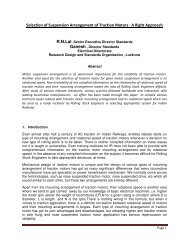

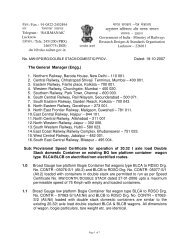
![Hkkjrljdkj] jsy ea= ky; vuql a/ kkuvfHkdYivkSj ekudlax Bu y ... - rdso](https://img.yumpu.com/21978459/1/184x260/hkkjrljdkj-jsy-ea-ky-vuql-a-kkuvfhkdyivksj-ekudlax-bu-y-rdso.jpg?quality=85)

